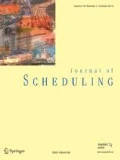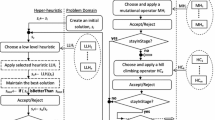Abstract
The application of the Late Acceptance Hill-Climbing (LAHC) to solve the High School Timetabling Problem is the subject of this manuscript. The original algorithm and two variants proposed here are tested jointly with other state-of-art methods to solve the instances proposed in the Third International Timetabling Competition. Following the same rules of the competition, the LAHC-based algorithms noticeably outperformed the winning methods. These results, and reports from the literature, suggest that the LAHC is a reliable method that can compete with the most employed local search algorithms.







Similar content being viewed by others
Notes
We denote by \(N_k(s)\) the subset of \(N_k(s)\) involving only moves of type k.
Code, solutions and reports are available at http://www.goal.ufop.br/softwares/hstt.
References
Abuhamdah, A. (2010). Experimental result of late acceptance randomized descent algorithm for solving course timetabling problems. IJCSNS-International Journal of Computer Science and Network Security, 10(1), 192–200.
Burke, E. K., & Bykov, Y. (2008). A late acceptance strategy in hill-climbing for exam timetabling problems. In PATAT’08 proceedings of the 7th international conference on the practice and theory of automated timetabling.
Burke, E. K., & Bykov, Y. (2012). The late acceptance hill-climbing heuristic. Technical Report CSM-192, Department of Computing Science and Mathematics, University of Stirling.
de Haan, P., Landman, R., Post, G., & Ruizenaar, H. (2007). A case study for timetabling in a dutch secondary school. In Lecture notes in computer science: VI. Practice and theory of automated timetabling (Vol. 3867, pp. 267–279). Berlin: Springer.
Dorneles, Á. P., de Araújo, O. C., & Buriol, L. S. (2014). A fix-and-optimize heuristic for the high school timetabling problem. Computers & Operations Research, 52, 29–38.
Fonseca, G., Santos, H., Toffolo, T., Brito, S., & Souza, M. (2012). A SA-ILS approach for the high school timetabling problem. In PATAT’12 proceedings of the 9th international conference on the practice and theory of automated timetabling.
Fonseca, G. H. G., Santos, H. G., Toffolo, T. A. M., Brito, S. S., & Souza, M. J. F. (2014). GOAL solver: A hybrid local search based solver for high school timetabling. Annals of Operations Research, 1–21. doi:10.1007/s10479-014-1685-4.
Garey, M. R., & Jonhson, D. S. (1979). Computers and intractability: A guide to the theory of NP-completeness. San Francisco, CA: Freeman.
IDSIA (2012). International Timetabling Competition 2002 (2012). Retrieved December, 2012 from http://www.idsia.ch/Files/ttcomp2002/.
Kheiri, A., Ozcan, E., & Parkes, A. J. (2012). Hysst: Hyper-heuristic search strategies and timetabling. In Proceedings of the ninth international conference on the practice and theory of automated timetabling (PATAT 2012) (pp. 497–499).
Kingston, J. (2014). KHE14 an algorithm for high school timetabling. In 10th international conference on the practice and theory of automated timetabling (pp. 26–29).
Kingston, J. H. (2005) A tiling algorithm for high school timetabling. In Lecture notes in computer science: V. Practice and theory of automated timetabling (Vol. 3616, pp. 208–225). Berlin: Springer.
Kingston, J. H. (2012). A software library for school timetabling (2012). Retrieved May, 2012, from http://sydney.edu.au/engineering/it/~jeff/khe/.
Kingston, J. H. (2012). A software library for school timetabling (2012). Retrieved December 2012, from http://sydney.edu.au/engineering/it/~jeff/khe/.
Kirkpatrick, S., Gelatt, C. D., & Vecchi, M. P. (1983). Optimization by simulated annealing. Science, 220, 671–680.
Kostuch, P. (2005). The university course timetabling problem with a three-phase approach. In Proceedings of the 5th international conference on practice and theory of automated timetabling, PATAT’04 (pp. 109–125). Berlin: Springer. doi:10.1007/11593577_7.
Kristiansen, S., Srensen, M., Stidsen, T. (2014). Integer programming for the generalized high school timetabling problem. Journal of Scheduling, 1–16. doi:10.1007/s10951-014-0405-x.
McCollum, B. (2012). International timetabling competition 2007. Retrieved December, 2012 from http://www.cs.qub.ac.uk/itc2007/.
Moura, A. V., & Scaraficci, R. A. (2010). A grasp strategy for a more constrained school timetabling problem. International Journal of Operational Research, 7(2), 152–170.
Muller, T. (2009). ITC2007 solver description: a hybrid approach. Annals OR 172(1), 429–446. http://dblp.uni-trier.de/db/journals/anor/anor172.html#Muller09.
Nurmi, K., & Kyngas, J. (2007). A framework for school timetabling problem. In Proceedings of the 3rd multidisciplinary international scheduling conference: theory and applications, Paris (pp. 386–393).
Özcan, E., Bykov, Y., Birben, M., & Burke, E. K. (2009). Examination timetabling using late acceptance hyper-heuristics. In Proceedings of the eleventh conference on congress on evolutionary computation, CEC’09 (pp. 997–1004). IEEE Press, Piscataway, NJ http://dl.acm.org/citation.cfm?id=1689599.1689731.
Pillay, N. (2013) A survey of school timetabling research. Annals of Operations Research, 1–33.
Post, G., Kingston, J., Ahmadi, S., Daskalaki, S., Gogos, C., Kyngas, J., et al. (2014). XHSTT: An XML archive for high school timetabling problems in different countries. Annals of Operations Research, 218(1), 295–301.
Romrs, J., & Homberger, J. (2012). An evolutionary algorithm for high school timetabling. In PATAT’12 proceedings of the 9th international conference on the practice and theory of automated timetabling.
Santos, H. G., Uchoa, E., Ochi, L. S., & Maculan, N. (2012). Strong bounds with cut and column generation for class-teacher timetabling. Annals OR, 194(1), 399–412.
Srensen, M., Kristiansen, S., & Stidsen, T. (2012). International timetabling competition 2011: An adaptive large neighborhood search algorithm (pp. 489–492).
Tuga, M., Berretta, R., & Mendes, A. (2007) A hybrid simulated annealing with kempe chain neighborhood for the university timetabling problem. In 6th IEEE/ACIS international conference on computer and information science, 2007. ICIS 2007, IEEE (pp. 400–405).
Valourix, C., & Housos, E. (2003). Constraint programming approach for school timetabling. In Computers & Operations Research (pp. 1555–1572).
Verstichel, J., & Vanden Berghe, G. (2009). A late acceptance algorithm for the lock scheduling problem. In S. Voss, J. Pahl, & S. Schwarze (Eds.), Logistik management (pp. 457–478). Dordrecht: Springer.
Wright, M. (1996). School timetabling using heuristic search. Journal of Operational Research Society, 47, 347–357.
Author information
Authors and Affiliations
Corresponding author
Rights and permissions
About this article
Cite this article
Fonseca, G.H.G., Santos, H.G. & Carrano, E.G. Late acceptance hill-climbing for high school timetabling. J Sched 19, 453–465 (2016). https://doi.org/10.1007/s10951-015-0458-5
Published:
Issue Date:
DOI: https://doi.org/10.1007/s10951-015-0458-5




